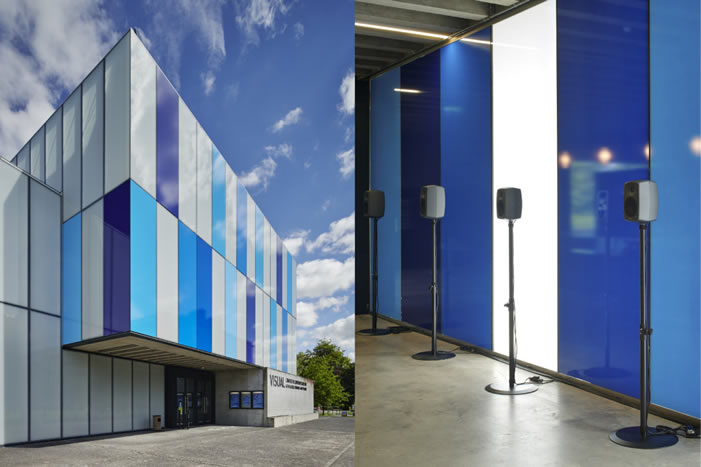Works
Tyndalls Blues, 2020, vinyl, glass, 8 loudspeakers, computer (light and generative sound installation), in collaboration with Mark Joyce, VISUAL Carlow, 23 July 2020 to 18 October 2020

Photos by Ros Kavanagh
Tyndall's Blues is an artistic collaboration between visual artist Mark Joyce and composer Fergal Dowling which responds to the transparent skin of Visual Carlow, designed by Terry Pawson as, 'an intersecting assembly of translucent glass volumes that transforms throughout the day as light passes through the building skin.'
Tyndall's Blues uses blue light and intermittent 'refracted' sound to explore the work of Carlow born John Tyndall (1820-93) the brilliant nineteenth-century experimental physicist, alpinist, progressive public intellectual and gifted science educator. One of the founders of climate science, he is remembered most famously for explaining why the sky is blue.
Video by Mark Joyce
Fergal Dowling and Mark Joyce in discussion
What was the initial impetus for this Light and Sound collaboration?
We met initially in 2018 to discuss working together with light and sound and the more general artistic challenges of combining colour with music or time-varying sound. We realised that site specificity, the architectural or spatial context would be a leading element and those early discussions went on to inform Tyndall?s Blues.
What is the connection with Tyndall?
John Tyndall (1820-93) was an experimental physicist, alpinist, progressive public intellectual and early popular science educator. He research investigated atmospheric phenomena, in particular how light and sound behaves in varying atmospheric conditions. He gave two series of lectures titled ‘Light’ and ‘Sound’ at the Royal Institute, which summarised the Victorian Newtonian understanding of these subject areas. These lectures were published and became the primers for scientific education. These remarkable texts and Tyndall’s whole approach resonated with our earlier considerations of how light and sound are experienced together.
What are the connections with light, sound and atmosphere?
As an early Alpinist, Tyndall was particularly aware of how light and sound behaved in various atmospheric conditions, and how the changing light in the mountains could inform the observer about approaching weather conditions; how spoken communications are impeded at altitudes and at distances (presumably he was familiar with Alphorns for signalling). One of the practical applications of his research was the development of ship horns that projected further and louder at sea in varying atmospheric conditions. Atmospherics, and the varying speeds of light and sound, create the physical conditions that form such phenomena as rainbows, thunder, lightning, mirages, echoes, sunsets and shadows.
How does Tyndall’s Blues relate to the architecture of Visual Carlow?
The Visual Carlow building has a distinctive glass skin, described by the architect Terry Pawson as ‘an intersecting assembly of translucent glass volumes that transforms throughout the day’. It appears that the building is made entirely of glass. On the outside it reflects the Carlow skies and the external atmosphere, while within it seems to act as a metaphor for an experimental chamber. The gallery in its entirety seems like a space where light passes from one medium to another.
How does the audience experience the work?
Visually there are five blue shades of industrial Vinyl, Cobalt, Ice, Pthalo, Azure and Light Blue, arranged across the glass exterior. The contiguity of these blues resembles the tonal chord clusters found in music keyboard charts. A row of eight loudspeakers line the entrance lobby, forming a ‘scale’ of progressively smaller speakers, which seem to act like portals in the skin of the building allowing light to enter, as if refracted and converted to sound.
How does the light and sound work together?
The blue colours in the buildings skin are close in hue, tone and saturation. These are Tyndall’s Blues, the hues that we see every day due to the scattering of electromagnetic waves in the Earth's atmosphere. The sounds from the loudspeakers emerge in a never-ending series of ‘waves’ and tumbling arpeggios of horns and bell plate percussion instruments that spread across the eight loudspeakers. We never hear the direct sound of these simulated instruments, but only their simulated reflections, as if we are listening to a virtual orchestra in an adjacent space and can only hear it through these eight slits in the wall.
These ‘waves’ emerge every minute or so, irregularly marking time like an unreliable clock. And, like the visual metaphor of white light refracting through a prism, the sound splinters into its component frequencies as distorted harmonics, and invades the space, fanning out throughout the galleries, and measuring the volume of the would-be experimental chamber.
It leaves in its trace a residue of sound colour, suspended in the air like our memory of the sound, like the residual mark of this light-and-sound experiment. Colour happens in our mind. By the time we experience a colour it has already become a thought or memory. In Tyndall’s Blues the architecture of Visual Carlow is deployed like the Victorian scientific apparatus used in the exploration of the physical world of light and sound.